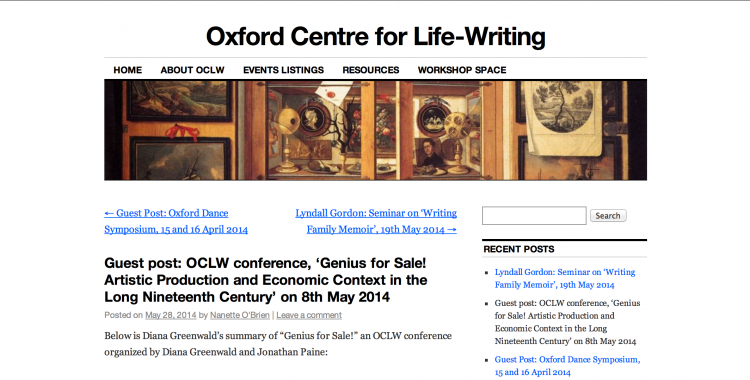
Genius For Sale! Blog Post on the OCLW Website
May 30, 2014
by Diana Greenwald | Filed in: Conferences
Check out co-organizer Diana Greenwald’s post about Genius for Sale! on the OCLW blog here.
Or read the whole blog post below…
Most academic conferences are discipline-specific— historians meet with historians, economists with economists, etc. The goal of “Genius for Sale! Artistic Production and Economic Context in the Long Nineteenth Century” was to break this pattern. This conference aimed to bring together scholars from a wide-range of disciplines who share an interest in the intersection between economics and the arts. Making interdisciplinarity of this scope successful is difficult. Co-organizer (and Wolfson student) Jonathan Paine wrote in his instructions to participants, “The challenge will be to retain the interest of specialists within each discipline while making sure that papers are accessible to a broader audience of academics in other disciplines who will be looking for themes of more general relevance.” The excellent group of speakers and discussants who participated in the conference not only achieved this goal, but also surpassed the organizers’ highest expectations.
Throughout the conference—in the introductory remarks, in the presentation and during the panel discussions—several recurring themes emerged. The first was an emphasis on the necessity of understanding the economic context of artists’ lives. This was the argument made in the introductions by Prof. Dame Hermione Lee and Dr. Philip Ross Bullock’ and in Narve Fulsas’ presentation about Ibsen. They all demonstrated that money concerns were central to famous writers’ and composers’ lives. This financial reality challenges an entrenched image of the starving artist who exists beyond monetary distraction. Going beyond this romantic myth and into Tchaikovsky’s, Henry James’ and Ibsen’s account books, Dr Bullock, Dame Prof. Lee and Prof. Fulsas scrutinized the personas that famous figures publically cultivated or that have been retroactively imposed on them. Prof. Karol Borowiecki’s presentation on the letters of famous composers also sought to examine a common generalization made about creative geniuses—that they are emotionally volatile and sad, and that this sadness is crucial to their creative process. Using instrumental variable analysis and drawing on recent research in the economics of wellbeing, he confirmed the existence of a link between negative emotion and creative output.
Prof. Borowiecki’s project was also representative of another attribute common to many of the presentations: the application of quantitative methodologies to sources and research questions that are normally the domain of qualitative research. Prof. Borowiecki’s work, along with that of Prof. Kathryn Graddy and Oxford doctoral student Diana Greenwald quantified evidence that is traditionally qualitative—letters, art exhibition records and descriptions of the color, line and other qualities of certain artists’ work. Converting qualitative evidence to quantitative allowed not only for the use of statistical tests, but also for a “zoomed out” view of evidence that is often examined word-by-word or canvas-by-canvas. From this perspective, one can see general trends that would be invisible when looking at smaller samples of art, literature or music in meticulous detail.
Finally, a number of presenters demonstrated that economics not only provides empirical quantitative methods, but useful theoretical lenses for understanding the arts. Dr Richard Taws’ presentation was organized around an in depth visual analysis of a painting by the French genre painter Swebach-Desfontaines. He situated the painting in the context of reciprocal flows of money, information and resources throughout the modernizing 19th-century French economy. These economic flows were not only relevant historical context, but the concept of flow also became an organizing structure for understanding the numerous complex themes at play in a specific work of art. Jonathan Paine and Prof. William Todd used economic concepts to analyze Russian literature. Paine proposed a framework for understanding how narrative behaves as an economic commodity, while Prof. Todd explained the sometimes-inconsistent behaviors of Russian publishers, editors, authors and state censors by viewing their choices through the lens of moral hazard.
The most important conclusion of the conference came from attendees’ reactions to the research presented. Their questions and comments made it clear that there is not only space, but rather demand for collaboration between humanities scholars and social scientists. The nuanced knowledge of sources provided by art historians and literary scholars paired with the empirical approaches of economists and sociologists can create potent arguments poised to overturn decades of received knowledge in different fields. As historian and presenter Prof. Robert Gildea said in his response to the last question of the day: “Now, it’s all up for grabs.”
Starting a List of Resources >>
<< The “Unwieldy” Archive, a Student Reaction to Genius For Sale!
